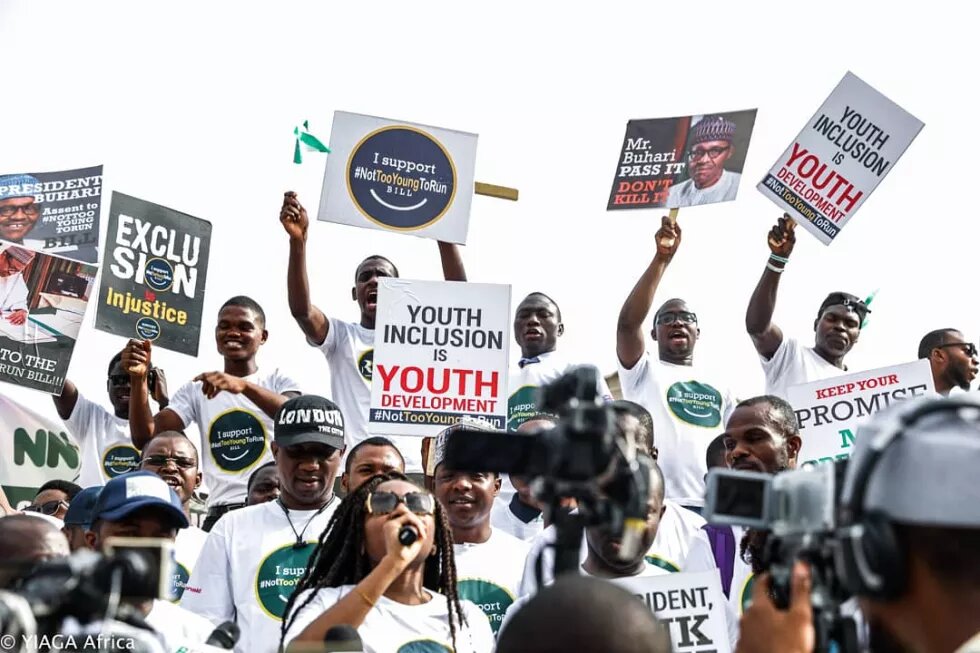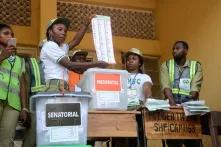
On 31 May 2018, President Muhammadu Buhari signed the Not Too Young to Run Act into law and, with the stroke of a pen, expanded the opportunities for young people to participate in Nigeria’s governance and politics in elective capacities.
The Act amended the Nigerian Constitution to lower the eligibility age for candidates to run for president or the offices of the Federal House of Representatives and the state houses of assembly, each by five years. This meant that young Nigerians did not have to wait until they were 30 years old to run for state or federal office or 40 years old to run for president. More importantly, it increased the opportunities for their participation in governance and decision-making.
This made an instant impact on the 2019 elections, first with a huge increase in the number of youth candidates and then with an increase in the number of young people elected to office. Ten of the 72 presidential candidates were aged between 35 and 40 years, while 1 515 youth candidates under the age of 35 – representing 23% of all the candidates – contested for seats in the House of Representatives. Specifically, 266 (17.5%) of the youth candidates who contested for seats in the House of Representatives in 2019 benefitted directly from the Not Too Young to Run Act.
The effect of the Act was also seen in the 2019 results. The number of federal representatives under the age of 35 went up from 3 (0.8%) before the 2019 elections to 13 (3.7%), while the number of state legislators under 35 years went from 6% to 9%.
Signing the bill into law on the eve of the election made the age of candidates a key campaign talking point and created a rising tide for all – candidates between the ages of 35 and 40, who did not depend on the constitutional amendment to run, also increased their elected numbers and older candidates did their best to portray themselves as young or young at heart.
However, despite these impacts, the Not Too Young to Run Act has only cracked open the door for more young people to be involved in governance and decision-making. In a country where about 70% of the population is below the age of 30, the proportion of elective seats held by people under the age of 35 is just 6.6% of a total of 1 558 seats available across the country.
Beyond the numbers
Young people also continue to face barriers within their political parties, including ageism, high costs of contesting and lack of internal democracy. Young women are disproportionately more affected by these than young men.
It is common to hear of young hopefuls who have been told to bide their time and leave room for older party members. Sometimes this comes after they have bought exorbitantly priced nomination and expression-of-interest forms. To contest for the Federal House of Representatives, for instance, aspirants in the main opposition Peoples Democratic Party (PDP) and the ruling All Progressives Congress (APC) pay N2.5 million (US$3 700) and N3.85 million (US$5 660) respectively.
Although some parties offer discounts for women, young people and persons with disabilities, the high cost of the forms is just one of many campaigning expenses. An aspirant can spend up to N25 million (US$37 000) to move through the primaries for a House of Representatives seat. To put this in perspective: 40% of people in Nigeria live below the national poverty line of N137 430 (US$381.75) per year, according to the World Bank.
Also, a lack of internal democracy in most political parties does not allow for a level playing ground or a free and fair process for selecting their election candidates. Young aspirants often find the ground tilted against them and, yet again, young female aspirants face an even steeper pitch. This is due to a mix of factors, including having less capacity to finance their campaigns, overt sexism (such as older male party members demanding sexual favours for support) and a patriarchal mindset that believes women do not make good leaders.
Older people also have broader networks that can easily be used to further their political aspirations, either in terms of campaign financing or otherwise. A 35-year-old aspirant’s network is mostly in the same age group and without the disposable income of a 55-year-old’s network.
Thus, although the Not Too Young to Run Act has helped to crack the glass ceiling for young people in elective politics, it is not enough alone to significantly increase the representation of youth either as candidates or as elected office-bearers. This is because the Act did not enshrine any affirmative-action targets for young people in government – which, if it had, would have been revolutionary on a global scale. Many countries have adopted affirmative action laws for women in governance (e.g., Rwanda, Senegal, South Africa) but there are no such supports for young people.
Holistic solutions needed
This means that the work that remains to be done has to happen outside of the legislature. Young people in political parties need to get better at organising within their parties, building their influence and leveraging it to win the necessary support from party leadership and pushing for fair internal democratic processes. This will require young people to close ranks within their parties, rather than simply accepting token positions and responsibilities. They will need to turn their numbers into a formidable bloc and demonstrate their capacity to be effective within the party so that they are given seats at the table. Considering the size of the youth vote in Nigeria, parties stand to benefit from fielding young candidates in elections as young voters will find them more relatable.
Young people can organise within their parties to push for affirmative action, such as reserving a percentage of party leadership positions and appointive seats in government for youths. This will tremendously increase their exposure, experience and chances to make a successful run for office.
More young people need to improve their capacity as politicians in terms of building networks, influence, leadership skills, fundraising ability and effectiveness. This is crucial to counteract the ageist perspective that fails to view their potential as capable and influential leaders and also tends to raise the bar for them compared to older people.
In recognition of this, the Not Too Young to Run movement, led by the civil society organisation Yiaga Africa, continues to organise a series of events called The Convergence that bring young aspirants and candidates together to build their capacity and inspire them to run effective campaigns. But because efforts like these often occur close to elections, when parties have already chosen candidates, they are also not enough on their own.
This means that aspiring young politicians must begin preparations as early as possible to overcome these disadvantages. There is an increasing availability of resources to help, such as capacity-building programmes run by the Electoral College and the School of Politics, Policy and Governance, and ElectHER Academy’s Future Lawmakers Programme targeted at young, female prospective candidates for legislative offices.
Political aspirants and analysts also expect that the Electoral Act 2022 will help to ensure that party candidates are selected through democratic means by strengthening oversight over their nomination processes. For example, in the case where a candidate is chosen by consensus, the law requires all other aspirants to consent to this in writing. This is intended to prevent party leaders from handpicking candidates without any fair contest.
2023 general elections outlook
The proportion of youth candidates in the 2023 elections has shrunk from 34% in 2019 to 28.6%. Of these candidates, 43.2% fall between the ages of 25 and 30 and are direct beneficiaries of the Not Too Young to Run Act. Only 11% of the youth candidates are women. As expected, political parties nominated more youth candidates for state legislative elections than for executive or federal legislative elections. About 35.6% of candidates for state assemblies are youth, along with 21.6% for the House of Representatives and only 3.7% for the Senate elections.
Reasons for the decline in youth candidacy again include the excessive cost of nomination forms along with highly commercialised party primaries, substitution of candidates and fewer political parties taking part. In 2020, the Independent National Electoral Commission deregisted 79 political parties for failing to meet their constitutional requirements, shrinking the field from 96 parties to the current 18.
It bears noting that smaller political parties such as the African Democratic Congress and the Action Democratic Party lead the rankings in terms of their proportion of youth candidates. Conversely, major parties like the APC and the PDP offered fewer opportunities for young people to emerge as candidates. This is chiefly due to stiffer competition in the major parties, as well as the higher costs of campaigning and poor internal democracy.
It is likely, then, that the proportion of young people elected next year will also decline. Importantly, those who are elected will likely come from the major parties with smaller proportions of youth candidates due to their electoral strengths.
While age is no longer the critical barrier it once was for young people to be a significant part of governance in Nigeria, there is still a lot of work to do towards this goal. Ongoing actions include strengthening laws such as the Electoral Act, excellent organising by young people within parties and the individual preparation of young aspirants. All of this can come together to good effect so that more young people, and especially young women, can secure their parties’ nomination to run in elections.
As we look forward to the 2023 elections, we also begin now to work towards ensuring that more young people with competence, character and capacity are on the ballot in 2027 and that there is an increase in both the proportion and the quality of young people in governance and decision-making.
The views expressed are those of the author and do not reflect the views or position of the Heinrich Boell Foundation.


